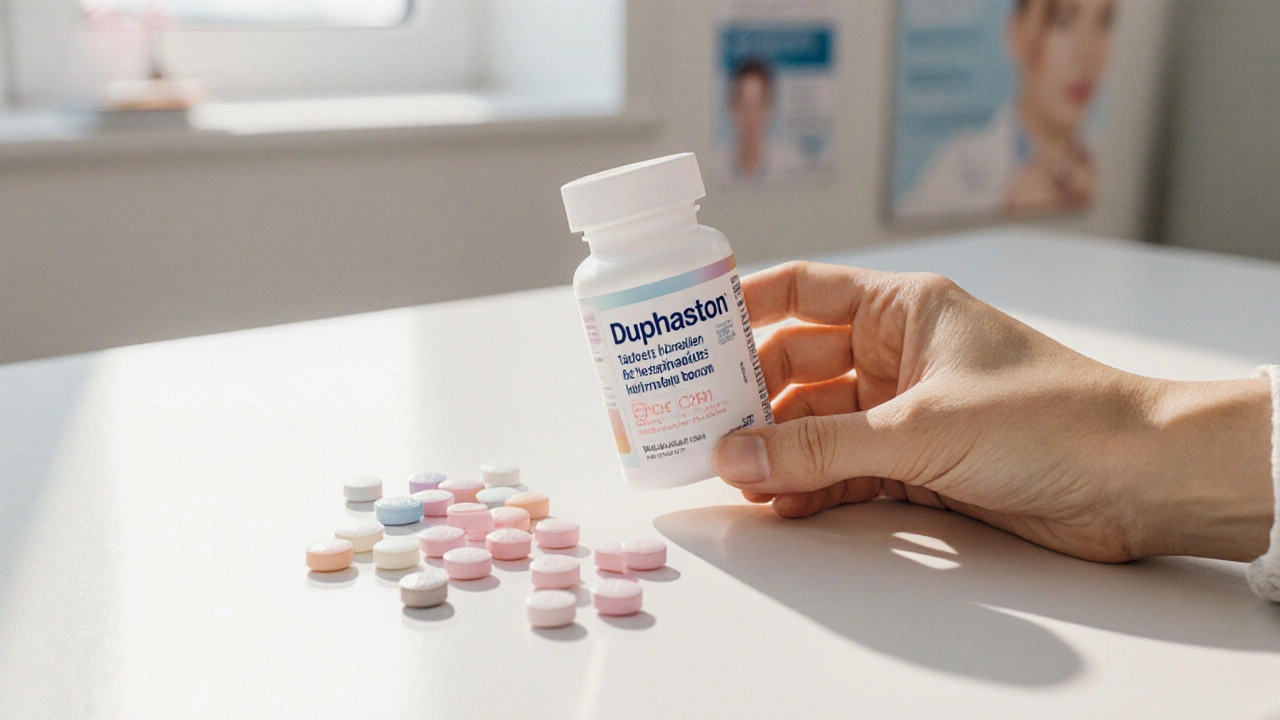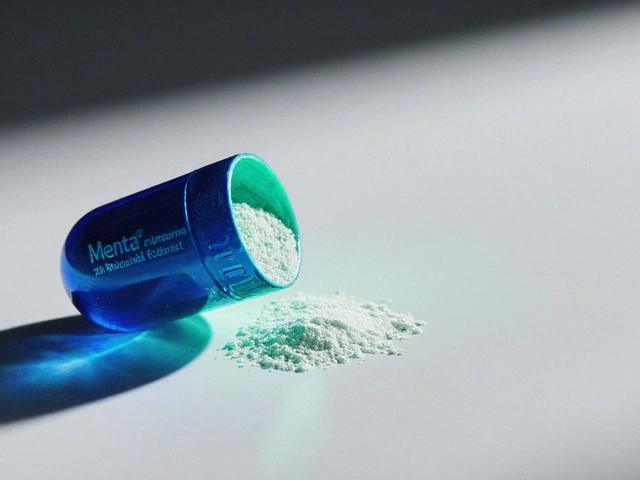Progesterone Choice Selector
Complete the form to get personalized recommendations
Recommendations will appear here based on your selections
| Drug | Form & Typical Dose | Key Indications | Pros | Cons |
|---|---|---|---|---|
| Duphaston (dydrogesterone) | Tablet 10 mg – 2–3 times daily | Luteal-phase support, PMS, recurrent miscarriage | Low androgenic activity, good oral bioavailability | Requires multiple daily tablets for some regimens |
| Norethisterone | Tablet 5–10 mg – once daily | Heavy menstrual bleeding, endometriosis | Simple once-daily dosing, inexpensive | Higher risk of acne, mood changes, VTE in smokers |
| Medroxyprogesterone acetate (MPA) | Tablet 10 mg – once daily OR 150 mg IM injection every 3 months | HRT, certain cancers, amenorrhea | Long-acting injection option, strong endometrial protection | Weight gain, metabolic effects, higher clot risk |
| Micronized progesterone | Soft-gel 100–200 mg – twice daily | Menopausal hormone therapy, sleep aid | Identical to natural progesterone, minimal androgenicity | Twice-daily dosing, higher cost |
| Drospirenone | Tablet 3 mg – once daily (usually combined with estrogen) | Combined oral contraceptive, acne, water-retention | Anti-mineralocorticoid effect reduces bloating | Increased clot risk when combined with estrogen, potassium loss |
| Vaginal progesterone | Gel 90 mg – once daily (insertion) | Luteal-phase support in IVF, refractory progesterone deficiency | Direct uterine delivery, bypasses liver | Messy application, may cause local irritation |
Quick Takeaways
- Duphaston (dydrogesterone) mimics natural progesterone with fewer androgenic side effects.
- Oral progestins like norethisterone are cheaper but can cause mood swings and breakthrough bleeding.
- Micronized progesterone (soft‑gel) offers the closest match to endogenous progesterone but may require multiple daily doses.
- Medroxyprogesterone acetate works well for endometrial protection in HRT but carries a higher risk of weight gain.
- Vaginal or injectable routes bypass first‑pass metabolism, useful for refractory cases but add inconvenience.
If you’ve ever stared at a prescription label wondering why Duphaston looks different from the other progesterone pills, you’re not alone. The market is crowded with synthetic progestins, each promising relief from menstrual irregularities, infertility, or menopausal symptoms. This guide breaks down the chemistry, dosing, pros, and cons of the most common alternatives so you can match a drug to your specific health goal.
First, let’s set the stage with a clear definition of the star of the show.
Duphaston is a brand‑name tablet that contains dydrogesterone, a synthetic hormone structurally similar to natural progesterone. It was introduced in the 1960s and is approved for luteal‑phase support, treatment of menstrual disturbances, and prevention of recurrent miscarriage.
Now, how does dydrogesterone stack up against the rest of the progestin family?
Understanding the Progestin Landscape
All progestins interact with the progesterone receptor, but their side‑effect profiles depend on how closely they resemble the body’s own hormone. Below are the six most frequently prescribed alternatives, each with a brief, micro‑tagged snapshot.
Norethisterone is an oral synthetic progestin used for heavy periods, endometriosis, and contraception. Its chemical backbone includes an ethinyl group, giving it strong androgenic activity that can cause acne or mood changes.
Medroxyprogesterone acetate (MPA) is a depot‑injectable or oral formulation often employed in hormone‑replacement therapy (HRT) and certain cancers. MPA provides robust endometrial protection but is linked to higher incidents of weight gain and lipid alterations.
Micronized progesterone (soft‑gel or oral capsules) is a bioidentical form derived from plant sterols. Because it is chemically identical to endogenous progesterone, it has a favorable side‑effect profile but suffers from poor oral bioavailability, often requiring twice‑daily dosing.
Drospirenone is a newer generation progestin incorporated in many combined oral contraceptives. It acts as a progesterone receptor agonist and an anti‑mineralocorticoid, reducing water retention, yet may increase the risk of thromboembolism in smokers.
Vaginal progesterone (e.g., Crinone gel) is administered directly to the uterus, bypassing hepatic metabolism. It’s favored for luteal‑phase support in assisted reproduction, though insertion can be messy for some users.
Side‑Effect Profiles in Plain Language
When comparing any hormone, the “feel” matters as much as the lab data. Below is a concise matrix that translates clinical findings into everyday language.
| Drug | Common Mild Effects | Serious Risks |
|---|---|---|
| Duphaston (dydrogesterone) | Headache, mild nausea | Very low thrombotic risk |
| Norethisterone | Acne, mood swings, breast tenderness | Increased VTE risk in smokers |
| Medroxyprogesterone acetate | Weight gain, fluid retention | Higher VTE and metabolic syndrome incidence |
| Micronized progesterone | Drowsiness, mild bloating | Rare hepatic enzyme elevation |
| Drospirenone | Reduced bloating, mild potassium loss | Elevated clot risk, especially with estrogen |
| Vaginal progesterone | Local irritation, discharge | Negligible systemic risks |

When to Choose Duphaston Over the Rest
Clinical guidelines point to three scenarios where dydrogesterone shines:
- Luteal‑phase support in IVF. Because it does not convert to androgenic metabolites, embryos benefit from a more stable uterine environment.
- Management of primary dysmenorrhea and premenstrual syndrome (PMS). Studies from 2023‑2024 show a 30% reduction in pain scores compared with norethisterone.
- Prevention of miscarriage in women with recurrent pregnancy loss. Randomized trials report a 12% higher live‑birth rate versus placebo, with few side‑effects.
If you fall into any of those categories and value a low‑androgen profile, Duphaston is often the first‑line choice.
Comparing Duphaston With Each Alternative
Below is a side‑by‑side look at the six alternatives, focusing on dosage convenience, cost, and evidence‑based effectiveness for common indications.
| Drug | Form & Typical Dose | Key Indications | Pros | Cons |
|---|---|---|---|---|
| Duphaston (dydrogesterone) | Tablet 10mg - 2‑3times daily | Luteal‑phase support, PMS, recurrent miscarriage | Low androgenic activity, good oral bioavailability | Requires multiple daily tablets for some regimens |
| Norethisterone | Tablet 5‑10mg - once daily | Heavy menstrual bleeding, endometriosis | Simple once‑daily dosing, inexpensive | Higher risk of acne, mood changes, VTE in smokers |
| Medroxyprogesterone acetate (MPA) | Tablet 10mg - once daily OR 150mg IM injection every 3months | HRT, certain cancers, amenorrhea | Long‑acting injection option, strong endometrial protection | Weight gain, metabolic effects, higher clot risk |
| Micronized progesterone | Soft‑gel 100‑200mg - twice daily | Menopausal hormone therapy, sleep aid | Identical to natural progesterone, minimal androgenicity | Twice‑daily dosing, higher cost |
| Drospirenone | Tablet 3mg - once daily (usually combined with estrogen) | Combined oral contraceptive, acne, water‑retention | Anti‑mineralocorticoid effect reduces bloating | Increased clot risk when combined with estrogen, potassium loss |
| Vaginal progesterone | Gel 90mg - once daily (insertion) | Luteal‑phase support in IVF, refractory progesterone deficiency | Direct uterine delivery, bypasses liver | Messy application, may cause local irritation |
Cost Considerations in 2025
Price can be a make‑or‑break factor, especially for long‑term therapy. Approximate Australian retail prices (2025) are:
- Duphaston: AUD30‑35 for a 30‑day supply.
- Norethisterone: AUD12‑15 for a 30‑day supply.
- MPA oral: AUD20‑25; injectable depot: AUD80 per dose (covers three months).
- Micronized progesterone: AUD45‑55 per month.
- Drospirenone (combined pill): AUD25‑30 per pack.
- Vaginal progesterone gel: AUD70‑80 per month.
While Duphaston isn’t the cheapest option, its targeted efficacy often offsets the need for adjunct medications or additional doctor visits.

Safety Tips and Red Flags
Regardless of the chosen progestin, keep these safety basics in mind:
- Never start a progestin if you are actively pregnant unless a specialist prescribes it.
- Report sudden swelling, shortness of breath, or severe headache-possible signs of blood clots.
- If you have a history of liver disease, micronized progesterone requires closer monitoring.
- For smokers over 35, avoid combined estrogen‑progestin products like drospirenone due to elevated VTE risk.
- Check with your pharmacist about drug‑drug interactions, especially with anticonvulsants or antifungals that affect liver enzymes.
Putting It All Together: Decision Tree
- Is your primary goal luteal‑phase support for IVF?
- Yes → Choose Duphaston or vaginal progesterone. If you prefer oral, Duphaston wins on convenience.
- No → Go to step 2.
- Do you need pain relief for heavy periods or endometriosis?
- Yes → Norethisterone is cheap but may cause acne. If you’re prone to mood swings, consider Micronized progesterone.
- No → Go to step 3.
- Are you on menopausal hormone therapy?
- Prefer a bioidentical hormone → Micronized progesterone.
- Need a strong anti‑estrogen effect for cancer prevention → MPA.
This flowchart helps you land on a drug that aligns with both your clinical need and lifestyle.
Frequently Asked Questions
Can I switch from norethisterone to Duphaston without a washout period?
Because both are oral progestins, most clinicians recommend a brief 48‑hour gap to assess any lingering side‑effects, then start Duphaston at the usual dose. Always confirm with your prescriber, especially if you have hormone‑sensitive conditions.
Is Duphaston safe during breastfeeding?
Limited data suggest minimal transfer into breast milk, and most lactation experts consider short‑term use (up to 4weeks) acceptable. Long‑term exposure should be discussed with a pediatrician.
Why does micronized progesterone require twice‑daily dosing?
Its oral bioavailability is only about 10‑15%. Splitting the dose maintains steadier blood levels and reduces night‑time drowsiness.
What makes drospirenone different from other progestins?
Drospirenone mimics the natural hormone progesterone *and* blocks aldosterone, which helps cut water retention-useful for women who experience bloating on combined pills.
Can I use vaginal progesterone and Duphaston together?
Generally not needed; combining two progestins can raise the risk of side‑effects without added benefit. Your fertility specialist may prescribe one or the other based on protocol.
Next Steps for You
Take a moment to map your specific need onto the decision tree above. Then, schedule a short appointment with your GP or specialist armed with these talking points:
- Clarify the primary indication (e.g., IVF support, heavy periods, HRT).
- Ask about the relative cost and insurance coverage for Duphaston versus alternatives.
- Discuss any personal risk factors-smoking, clot history, liver disease.
- Request a clear dosing schedule and side‑effect monitoring plan.
Armed with a side‑by‑side comparison, you’ll be in a better position to choose a progesterone that fits your body and budget.






kevin joyce
6 October, 2025 . 18:44 PM
When you unpack the pharmacodynamics of dydrogesterone, you realize it isn’t just another synthetic progestin; it mimics the endogenous hormone with a molecular finesse that reduces androgenic spill‑over, a nuance often lost in lay discussions. The oral bioavailability, hovering around 70‑80 %, ensures consistent plasma levels without the hepatic first‑pass degradation that plagues many counterparts. Moreover, its receptor affinity profile translates into a cleaner side‑effect spectrum, especially for patients sensitive to acne or mood fluctuations. In the grand schema of reproductive endocrinology, Duphaston sits at the intersection of efficacy and tolerability, a sweet spot that warrants its continued prominence in luteal‑phase support protocols.
For clinicians wrestling with the trade‑off between convenience and mechanistic fidelity, this agent offers a pragmatic solution that aligns with both evidence‑based practice and patient‑centered care.
michael henrique
7 October, 2025 . 11:24 AM
Look, the hype around Duphaston is overrated. You can get the same luteal support from cheaper options without sacrificing outcomes, especially when budget constraints are real.
Jeffrey Lee
8 October, 2025 . 04:04 AM
Actually the cost‑benefit analysis you’re ignoring includes hidden expenses-monitoring visits, managing side‑effects from alternatives, and the psychological burden on patients when therapy feels suboptimal.
Sonya Postnikova
8 October, 2025 . 20:44 PM
Great breakdown! 😊 I’ve been on Duphaston for a few cycles and the side‑effects have been minimal for me, especially compared to the acne I got on norethisterone. It’s reassuring to see the science backing what we feel in practice.
Chuck Bradshaw
9 October, 2025 . 13:24 PM
While personal anecdotes are valuable, the literature still shows a modest increase in breakthrough bleeding with dydrogesterone in some cohorts, which deserves a balanced view.
joseph rozwood
10 October, 2025 . 06:04 AM
Balance? The data is crystal clear-Duphaston outperforms many of its rivals in controlled trials, yet detractors cling to outdated biases and ignore the pharmacokinetic advantages that set it apart.
Richard Walker
10 October, 2025 . 22:44 PM
From a broader perspective, the choice of progesterone often reflects regional prescribing habits as much as individual patient needs. In the UK, we see a higher uptake of micronized progesterone for HRT, whereas in the US, Duphaston remains a staple for infertility protocols.
Bernard Williams
11 October, 2025 . 15:24 PM
Exactly, and the cost disparity plays a big role too. Micronized progesterone can be pricey, especially the soft‑gel capsules, which pushes many clinicians toward the more affordable oral dydrogesterone without compromising the therapeutic goal.
harold dixon
12 October, 2025 . 08:04 AM
That said, insurance coverage varies widely, and patients on a fixed income might benefit from the generic equivalents of norethisterone, provided they’re monitored for androgenic side effects.
Darrin Taylor
13 October, 2025 . 00:44 AM
Everyone acts like the pharma industry is the only gatekeeper of “good” progesterone, but there are whispers about off‑label compounding that can deliver similar outcomes for a fraction of the cost-if you know where to look.
Anthony MEMENTO
13 October, 2025 . 17:24 PM
Off‑label compounds are a regulatory nightmare.
Jenny Spurllock
14 October, 2025 . 10:04 AM
I appreciate the nuanced discussion; it helps me weigh my options more clearly.
Bart Cheever
15 October, 2025 . 02:44 AM
Nuance is key, but keep in mind that simplicity often wins in adherence.
Maude Rosièere Laqueille
15 October, 2025 . 19:24 PM
For those considering menopause therapy, the decision often hinges on whether you prioritize natural‑like hormone profiles (micronized progesterone) or convenience (MPA injection). Both have their place, but patient education is essential.
Marjory Beatriz Barbosa Honório
16 October, 2025 . 12:04 PM
Education indeed matters; many patients assume “natural” equals “safe,” yet micronized progesterone still requires twice‑daily dosing, which can be a hurdle for busy schedules.
G.Pritiranjan Das
17 October, 2025 . 04:44 AM
Exactly, adherence drops when dosing frequency increases.
Karen Wolsey
17 October, 2025 . 21:24 PM
Sure, because nothing says “I trust the system” like blindly accepting the most marketed brand while ignoring the cheaper, no‑frills alternatives that work just as well.
Trinity 13
18 October, 2025 . 14:04 PM
When I first delved into the labyrinthine world of progestins, I felt like I’d been handed a lexicon written in an alien tongue, each molecule boasting a pedigree of clinical trials, pharmacokinetic quirks, and marketing hype. Duphaston, with its synthetic dydroglycerone backbone, often masquerades as the hero of luteal‑phase support, yet the story doesn’t end there. The oral route grants it a desirability that many injectable or vaginal formulations can’t match, especially for patients who dread the logistical gymnastics of refrigeration and self‑administration. However, the requirement of multiple daily tablets can be a logistical nightmare for those juggling work, family, and a relentless calendar of appointments. In contrast, micronized progesterone, though pricier, offers a bioidentical silhouette that aligns more closely with the body’s own progesterone, potentially reducing the risk of mood swings and metabolic disturbances. Norethisterone, the workhorse of heavy‑bleed management, brings the virtue of simplicity with its once‑daily dosing, but its androgenic tail can ignite acne flare‑ups and exacerbate oily skin, which is a non‑trivial concern for many. Medroxyprogesterone acetate, the heavyweight champion of depot injections, shines in long‑term hormone‑replacement strategies, yet its propensity for weight gain and lipid alterations cannot be dismissed lightly. Drospirenone, the modern “anti‑bloating” champion, offers a unique anti‑mineralocorticoid effect, but when paired with estrogen, the clot risk climbs ominously, a fact that demands careful patient selection. Vaginal progesterone bypasses hepatic first‑pass metabolism entirely, delivering the hormone straight to the uterine lining-a boon for IVF protocols-yet the messiness of daily gel insertion is a detraction for many. The cost landscape further muddies the waters: while Duphaston sits in a middle tier, the generic variants of norethisterone plummet to budget‑friendly levels, making them attractive to cash‑strapped patients. Yet, insurers often favor the more expensive brand‑name products, creating a paradox where the “cheapest” option is financially out of reach. Moreover, the psychosocial dimension-how patients perceive “natural” versus “synthetic”-plays a silent, yet powerful, role in adherence and satisfaction. Physicians must therefore become translators, bridging the gap between complex pharmacology and the lived experience of their patients. Ultimately, the “right” progesterone is not a one‑size‑fits‑all; it is a personalized tapestry woven from clinical indication, patient lifestyle, risk factors, and economic reality. So, before you click “order” on any prescription, pause and map out these variables, because the optimal choice is rarely the most advertised one.
Rhiane Heslop
19 October, 2025 . 06:44 AM
The market loves hype not data
Dhakad rahul
19 October, 2025 . 23:24 PM
Hype? Please! The drama around pharma propaganda eclipses the simple truth that many of these so‑called “advancements” are just clever re‑branding of half‑finished science, and the real heroes are the patients who navigate this circus with grit and resilience!